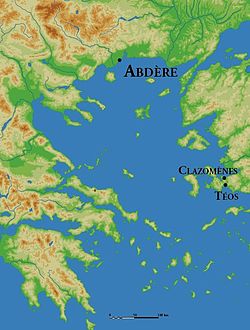Abdera, Thrace
- For other cities with the same name see Abdera



Abdera (Άβδηρα) was a town on the coast of Thrace 17 km east-northeast of the mouth of the Nestos, and almost opposite Thasos. At coordinates 40°57′N 24°59′E / 40.950°N 24.983°E, the site now lies in the Xanthi Prefecture of modern Greece. The current municipality of Abdera, or Avdira, has 3,917 inhabitants (2001).
Its mythical foundation was attributed to Heracles (on behalf of his fallen friend Abderus), its historical one to a colony from Klazomenai. This historical founding was traditionally dated to 654 BC, which is unverified, although evidence in 7th century BC Greek pottery tends to support it.[1] But its prosperity dates from 544 BC, when the majority of the people of Teos (including the poet Anacreon) migrated to Abdera to escape the Persian yoke (Herodotus i.168). The chief coin type, a griffon, is identical with that of Teos; the rich silver coinage is noted for the beauty and variety of its reverse types.
In 513 BC and 512 BC, the Persians conquered Abdera. In 492 BC, the Persians again conquered Abdera, this time under Darius I. It later became part of the Delian League and fought on the side of Athens in the Peloponnesian war.
Abdera was a wealthy city, the third richest in the League, due to its production of corn and status as a prime port for trade with the interior of Thrace and the Odrysian kingdom.[1]
A valuable prize, the city was repeatedly sacked: by the Triballi in 376 BC, Philip II of Macedon in 350 BC; later by Lysimachos of Thrace, the Seleucids, the Ptolemies, and again by the Macedonians. In 170 BC the Roman armies and those of Eumenes II of Pergamon besieged and sacked it.
The town seems to have declined in importance after the middle of the 4th century BC. The air of Abdera was proverbial in Athens as causing stupidity,[2] but it counted among its citizens the philosophers Democritus and Protagoras, and historian and philosopher Hecataeus of Abdera.
The ruins of the town may still be seen on Cape Balastra; they cover seven small hills, and extend from an eastern to a western harbor; on the southwestern hills are the remains of the medieval settlement of Polystylon.
Abdera is a titular see of the Roman Catholic Church in the province of Rhodope on the southern coast of Thrace, now called Bouloustra.
Sources
- Grant, Michael. A Guide to the Ancient World. Michael Grant Publications, 1986.
Notes
- ^ a b Hornblower, Simon (1996). "Abdera". The Oxford Classical Dictionary. Oxford: Oxford University Press. p. 1.
- ^ Cicero, Epistulae ad Atticum. 4.17.3, 7.7.4.
External links
- Richard Stillwell, ed. Princeton Encyclopedia of Classical Sites, 1976: "Abdera, Thrace, Greece"
- http://www.culture.gr/2/21/211/21119a/e211sa05.html (English)
- http://www.avdera.gr/ (Greek)
This article incorporates text from a publication now in the public domain: Chisholm, Hugh, ed. (1911). Encyclopædia Britannica (11th ed.). Cambridge University Press. {{cite encyclopedia}}: Missing or empty |title= (help)
![]() This article incorporates text from a publication now in the public domain: Herbermann, Charles, ed. (1913). Catholic Encyclopedia. New York: Robert Appleton Company.
This article incorporates text from a publication now in the public domain: Herbermann, Charles, ed. (1913). Catholic Encyclopedia. New York: Robert Appleton Company. {{cite encyclopedia}}: Missing or empty |title= (help)
Template:Xanthi
